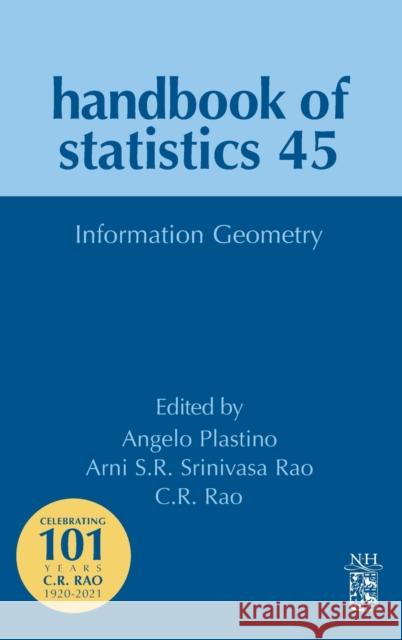Information Geometry: Volume 45 » książka



Information Geometry: Volume 45
ISBN-13: 9780323855679 / Angielski / Twarda / 2021 / 248 str.
Information Geometry: Volume 45
ISBN-13: 9780323855679 / Angielski / Twarda / 2021 / 248 str.
(netto: 931,00 VAT: 5%)
Najniższa cena z 30 dni: 965,58
ok. 30 dni roboczych.
Darmowa dostawa!
"From the cover of the book: "Introduction to probability and statistics for engineers and scientists, now in its trusted Sixth Edition, provides a valuable overview of the subject written in the engaging style of Best-Selling Probability expert and author, Sheldon Ross. The book uniquely emphasizes how probability informs statistical problems to develop an intuitive understanding of the statistical procedures most commonly used by practicing engineers and scientists. Utilizing real data from actual studies across life science, engineering, computing and business, this useful introduction supports reader comprehension through a wide variety of exercises and examples throughout the text. These examples and exercises are combined with updated problem sets and applications to connect probability theory to everyday statistical problems and situations....The book can be very recommended to all readers, students and instructors, who are interested in this field." --zbMath/European Mathematical Society and the Heidelberg Academy of Sciences and Humanities
Section I Foundations of information geometry 1. Revisiting the connection between Fisher information and entropy's rate of change A.R. Plastino, A. Plastino, and F. Pennini 2. Pythagoras theorem in information geometry and applications to generalized linear models Shinto Eguchi 3. Rao distances and conformal mapping Arni S.R. Srinivasa Rao and Steven G. Krantz 4. Cramer-Rao inequality for testing the suitability of divergent partition functions Angelo Plastino, Mario Carlos Rocca, and Diana Monteoliva 5. Information geometry and classical Cram
Arni S.R. Srinivasa Rao works in pure mathematics, applied mathematics, probability, and artificial intelligence and applications in medicine. He is a Professor at the Medical College of Georgia, Augusta University, U.S.A, and the Director of the Laboratory for Theory and Mathematical Modeling housed within the Division of Infectious Diseases, Medical College of Georgia, Augusta, U.S.A. Previously, Dr. Rao conducted research and/or taught at Mathematical Institute, University of Oxford (2003, 2005-07), Indian Statistical Institute (1998-2002, 2006-2012), Indian Institute of Science (2002-04), University of Guelph (2004-06). Until 2012, Dr. Rao held a permanent faculty position at the Indian Statistical Institute. He has won the Heiwa-Nakajima Award (Japan) and Fast Track Young Scientists Fellowship in Mathematical Sciences (DST, New Delhi). Dr. Rao also proved a major theorem in stationary population models, such as, Rao's Partition Theorem in Populations, Rao-Carey Theorem in stationary populations, and developed mathematical modeling-based policies for the spread of diseases like HIV, H5N1, COVID-19, etc. He developed a new set of network models for understanding avian pathogen biology on grid graphs (these were called chicken walk models), AI Models for COVID-19 and received wide coverage in the science media. Recently, he developed concepts such as "Exact Deep Learning Machines, and "Multilevel Contours within a bundle of Complex Number Planes. book "Ancient Inhabitants of Jebel Moya published by the Cambridge Press under the joint authorship of Rao and two anthropologists. On the basis of work done at CU during the two year period, 1946-1948, Rao earned a Ph.D. degree and a few years later Sc.D. degree of CU and the rare honor of life fellowship of Kings College, Cambridge.
He retired from ISI in 1980 at the mandatory age of 60 after working for 40 years during which period he developed ISI as an international center for statistical education and research. He also took an active part in establishing state statistical bureaus to collect local statistics and transmitting them to Central Statistical Organization in New Delhi. Rao played a pivitol role in launching undergraduate and postgraduate courses at ISI. He is the author of 475 research publications and several breakthrough papers contributing to statistical theory and methodology for applications to problems in all areas of human endeavor. There are a number of classical statistical terms named after him, the most popular of which are Cramer-Rao inequality, Rao-Blackwellization, Rao's Orthogonal arrays used in quality control, Rao's score test, Rao's Quadratic Entropy used in ecological work, Rao's metric and distance which are incorporated in most statistical books.
He is the author of 10 books, of which two important books are, Linear Statistical Inference which is translated into German, Russian, Czec, Polish and Japanese languages,and Statistics and Truth which is translated into, French, German, Japanese, Mainland Chinese, Taiwan Chinese, Turkish and Korean languages.
He directed the research work of 50 students for the Ph.D. degrees who in turn produced 500 Ph.D.'s. Rao received 38 hon. Doctorate degree from universities in 19 countries spanning 6 continents. He received the highest awards in statistics in USA,UK and India: National Medal of Science awarded by the president of USA, Indian National Medal of Science awarded by the Prime Minister of India and the Guy Medal in Gold awarded by the Royal Statistical Society, UK. Rao was a recipient of the first batch of Bhatnagar awards in 1959 for mathematical sciences and and numerous medals in India and abroad from Science Academies. He is a Fellow of Royal Society (FRS),UK, and member of National Academy of Sciences, USA, Lithuania and Europe. In his honor a research Institute named as CRRAO ADVANCED INSTITUTE OF MATHEMATICS, STATISTICS AND COMPUTER SCIENCE was established in the campus of Hyderabad University.
Angelo Plastino, PhD is Emeritus Professor of Physics, La Plata National University, Honorary Professor, University of Buenos Aires, Doctor Honoris Causa, University of Pretoria, Member of the Brazilian Academy of Sciences, Member of the Mexican Academy of Sciences, received the Scopus Elsevier Award to the most cited Argentine physicist in the period 1998-2008 and is the author of 680 refereed papers published in scientific journals (up to December 2020).1997-2026 DolnySlask.com Agencja Internetowa
KrainaKsiazek.PL - Księgarnia Internetowa









